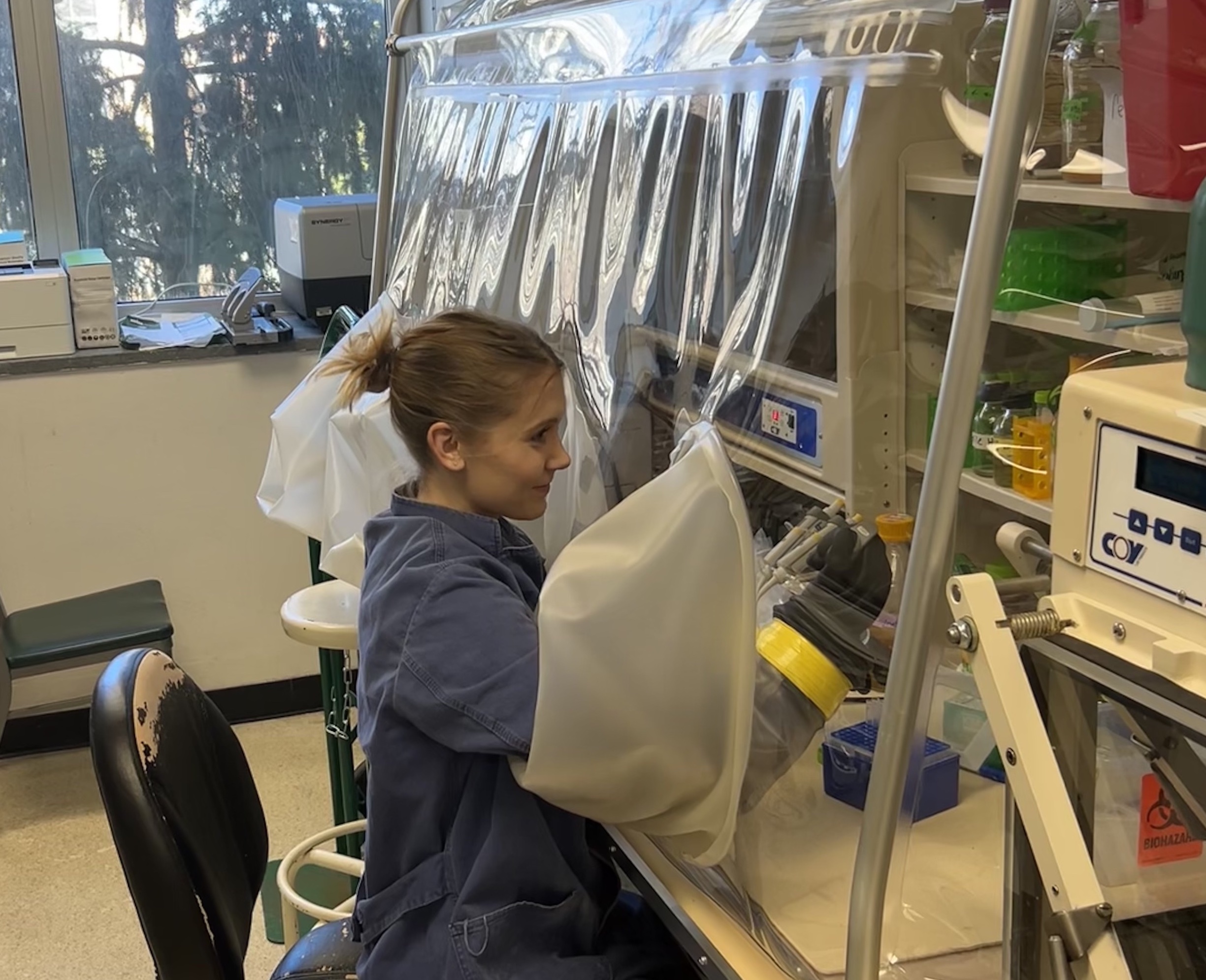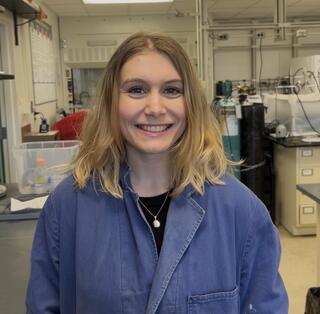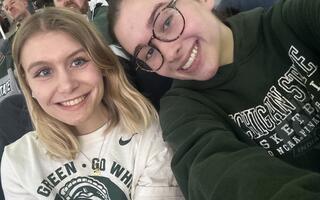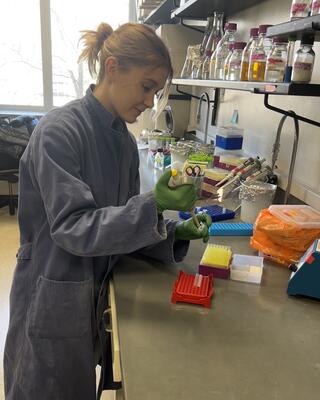
In this series, we learn more about what inspired our talented graduate students and postdoctoral researchers, what brought them to their field of study, and the questions that drive their work as part of the Great Lakes Bioenergy Research Center.
The latest spotlight features Emma Boismier, a first year graduate student in the TerAvest Lab within Michigan State University's Biochemistry Department. Boismier was born and raised in Michigan, and earned a bachelor's in genomics and molecular genetics. Read on to learn how she's come to pursue a PhD in biochemistry.
What sparked your interest in genomics, molecular genetics, and microbiology?
My undergrad was here at MSU, and I majored in genomics and molecular genetics. I always liked science a lot. In my high school, I was a part of a STEM program. I picked genetics because I just thought it would be interesting. After graduating, I worked for a year in a lab in the MSU Physiology Department as a lab aide. Then I joined graduate school.
I started doing research as an undergraduate. The main thing that got me into research was MSU's iGEM (International Genetically Engineered Machine) Team. It's an international synthetic biology competition. We would pick our own projects in the spring semester, and then over the summer we would work in the lab and do experiments. In the fall, you give a presentation to the judges, competing against other teams. It's synthetic biology, so genetically engineering organisms for useful applications. That made me really passionate about research and want to go get my PhD.

What originally drew you to MSU?
I'm from Michigan, so it was just kind of natural for me to come here. I wasn't too certain of what I wanted to do when I came to college, so I thought a big university would be good to figure it out.
One of the reasons I wanted to go to MSU is because it's a big agricultural school. So we're really big on environmental studies and agriculture. And that's something I'm interested in because I'm really passionate about the environment and climate change. So a lot of the research here is geared toward that. I also have two sisters who go here, so it's nice to have my family.
I decided to stay at MSU for my PhD because I really love MSU. The research community is really supportive, and I think there's really cool research going on here.
How did you end up in Michaela TerAvest's lab?
iGEM made me really interested in synthetic biology, and I wanted to pursue something in that field. Michaela's lab does focus on synthetic biology applications and bacteria, so I was really interested in that. And learning more about the project, with the GLBRC, it seemed like a great opportunity with a lot of resources and a really good common research goal... to advance biofuels and bioproducts. And Michaela is an amazing mentor. I really like the culture in her lab and all the people in her lab. I'm lucky to be able to do research every day. I think it's really fun, and it's exciting to be discovering new things.
What supports have helped you through your academic career?
I think as a general support system, probably my parents and my sisters. We're all close, and they have helped me throughout my journey to graduate school and are always there for me.

When I was an undergrad, I worked for Dr. Gemma Reguera in the microbiology, genetics, and immunology department, and she was a really amazing mentor. She taught me how academic research is conducted and sparked my passion for environmental microbiology. When I was a lab aide in the Physiology Department I worked with a graduate student named Meena Sudhakaran who mentored me in that lab and who also helped me with research. I worked really closely with her for that year. She is an amazing, supportive person and taught me a lot about what it's like being a graduate student and gives me a lot of advice. Even now we hang out a lot. So she's someone who I look up to.
What are you working on in the lab?
I'm working on a bacteria called Zymomonas mobilis. It's very efficient at fermenting glucose into ethanol, which can be used as a biofuel. My project is going to be focusing on increasing the carbon use efficiency in Zymomonas. That could be either increasing the carbon that's in the lignocellulosic hydrolysate or preventing carbon dioxide release. And that's important moving forward for a carbon neutral economy.

This would be accomplished by engineering metabolic pathways in Zymomonas to better complete those goals. So it has to do with metabolism and how Zymomonas uses energy.
I'm still figuring out my projects, so one other thing I'm working on is a bioinformatics project looking at oxidative stress gene regulation. It looks at which genes could be responsible for producing a stress response in the bacteria, and growing in hydrolysate would be a stressful environment. And I've been getting a lot of help from the GLBRC bioinformatics team. They've been helping me analyze transcriptomics data.
What does this process look like?
This process usually starts with putting a gene inside Zymomonas that it doesn't normally have, and then we would test if this has a positive effect using a particular type of substrate. So I would use molecular biology techniques to create a plasmid with this gene, then I would put the plasmid into the bacteria. And then I'd probably do a growth curve and do a high performance liquid chromatography experiment to see what carbon compounds the bacteria is producing and consuming.
What does it mean to be working with GLBRC?
I'm really grateful to be a part of it because there is a broader mission, and it's exciting to be a part of something bigger than yourself. I’ve always really enjoyed nature, especially being from Michigan and being surrounded by the Great Lakes. I find climate change really concerning, and I feel like, even this winter, we can kind of all tell that the climate is changing. So it's becoming more real. I think it's exciting to be able to try to make a difference in a small way.
Where do you see yourself in the next several years?
I'm not too sure, career wise, what I want to do afterwards. Probably either stay in academia and have my own lab or go into industry. I’m also considering government jobs. I could see myself being happy doing any of those options, so I'm not too sure yet. But I would like to continue working in synthetic biology and working on things that have environmental impact. And I do really like the metabolic engineering I'm doing now, so I could see myself continuing forward with that for different bio product applications.
What do you do when you're not in the lab?
I do high-intensity interval training during the week, which I really like, and I also like running. And I volunteer at an animal shelter in Lansing. I've been trying to teach myself calligraphy for a little bit. My grandpa used to be an art teacher, and so he knows how to do calligraphy, and he would teach my sisters and I sometimes. I also recently got involved with this group on campus that's trying to build a tropical biodome structure in the area. Other than that I enjoy going to different sports games at MSU.